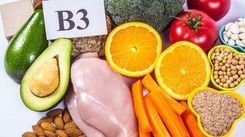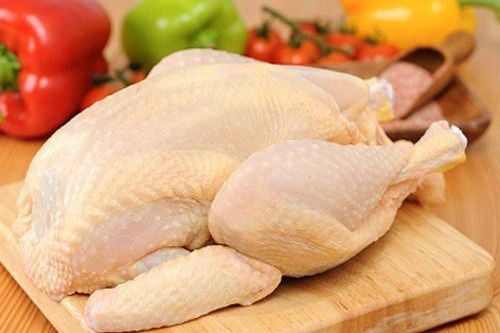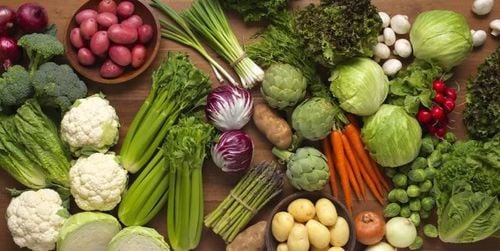Chicken has high nutritional value, whether people with gout can eat chicken or not will depend on how to use and prepare this dish. Because chicken contains a significant amount of purine, healthy purine food sources can protect blood vessels, but too much will cause gout flare-ups.
1. Can people with gout eat chicken?
Chicken is a lean meat with high nutritional value, but people with gout (excess uric acid in the body) need to be careful about how to use meat, how much to eat and how to prepare chicken.
If you have gout, you need to consume chicken carefully. Chicken has a significant amount of purines. Healthy food sources of purines can protect blood vessels, but too much will cause gout flare-ups. Research has shown that excess purines cause high uric acid levels (meaning hyperuricemia) and lead to uric acid crystals in the joints (typically in the big toe), causing pain for the patient and more dangerously can lead to disability.
2. Nutritional Value of Chicken
Chicken is a high-protein, low-sodium, low-sugar, and starch-free food option that provides essential nutrients needed for a healthy metabolism, including antioxidant B vitamins (B6, niacin) and minerals such as selenium and phosphorus. Unlike meats, especially red meat, poultry, including skinless, boneless chicken breast, has become a popular animal protein for people who want to eat a healthy diet while losing or maintaining weight.
Maintaining weight is one of the most important lifestyle adjustments for people with gout and obesity. People with gout also need to reduce the amount of purines in their diet.
The American Heart Association also recommends choosing skinless poultry and fish, and preparing them in healthy ways that do not add saturated and trans fats to the diet. Experts also say that nutrient-rich foods like chicken can help you control your weight, cholesterol, and blood pressure. Therefore, "can people with gout eat chicken" depends on how it is prepared as well as the purine content in the chicken.

3. The best way to reduce purine intake
The nutritional value of chicken meat is basically different between the breast, thigh, and wing. The purine content of chicken meat will be distributed differently in different parts of the chicken. For people with gout and hyperuricemia, the total purine intake and the types of purines consumed, especially hypoxanthine, need to be carefully considered.
In Japan, the guidelines for the management of hyperuricemia and gout recommend reducing the amount of purines in the diet to less than 400 mg/day.
Chicken meat is mainly a moderate purine food, but the purine content of meats varies from low to very high. Therefore, people with gout should avoid organ meats such as chicken liver and only eat foods with moderate purine content in reasonable portions.
According to the American Dietetic Association, purine-rich foods have a total purine content of 150-1000 mg/100g and people with gout or hyperuricemia should avoid these foods.
Purines in chicken/100g:
Rump accounts for a low content of 68.8 mg
Breast, skinless, moderate content of 141.2 mg
Wings, moderate content of 137.5 mg
Legs, moderate content of 122.9 mg
Liver, high content of <300 mg
Specific purine breakdown is also considered good information to help you make an informed choice about whether gout patients can eat chicken. You should be wary of foods high in adenine and hypoxanthine, as these purines have been shown to have a significant association with gout.
4. Cooking Tips for Gout Sufferers
You can reduce the total purine content of your chicken by following some of these guidelines:
The first thing you can do is remove the skin, as it contains additional purines and unhealthy fats.
Researchers suggest that washing and cooking chicken in water can significantly reduce the total purine content of some animal proteins such as fish.
Cooking in general, whether by moist heat (boiling) or dry heat (grilling), has been found to have similar effects on purine content. This process will slightly increase adenine, guanine and decrease hypoxanthine compared to raw food. Cooking reduces the purine content of chicken partly because they are released into the juices. This explains why some sauces such as gravies or stocks and soups are considered high in purines. Therefore, cooking chicken by frying, grilling, and stewing will release purines and absorb them into the broth.

5. Foods to Avoid When You Have Gout
You should avoid the following foods if you have gout:
Alcohol
Full-fat dairy
Animal fats
The oils and sauces you use to season and cook chicken also play an important role for people with gout. Choose high-quality vegetable oils with anti-inflammatory properties such as extra virgin olive oil and avocado oil. These oils can be used to cook and marinate chicken. Season foods and flavors with anti-inflammatory ingredients such as chili, tomatoes, turmeric, etc.
The purine content of chicken is also affected by temperature and storage time. Lower storage temperatures and storage times have reduced enzyme activity as well as the overall purine content of shrimp, which has shown similar results for chicken.
In short, whether gout patients can eat chicken depends on how it is prepared and the purine content of chicken. Therefore, people with gout should learn appropriate chicken cooking methods for their existing medical condition.
To arrange an appointment, please call HOTLINE or make your reservation directly HERE. You may also download the MyVinmec app to schedule appointments faster and manage your reservations more conveniently.
Reference source: webmd.com, verywellhealth.com












